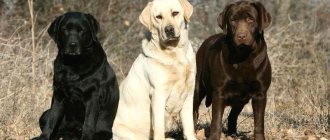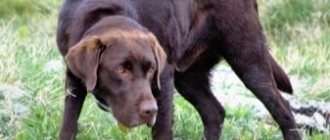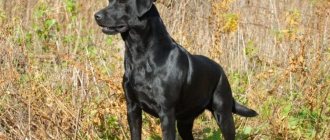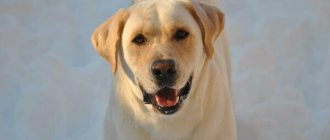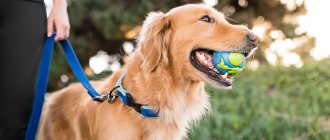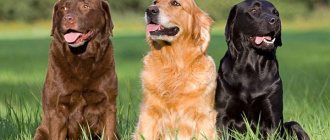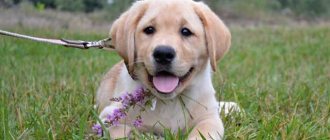Labradors are a very popular dog breed. They are turned on because they excellent companions, friendly and playful.
With their large size (height at withers reaches 60 cm and weight up to 35 kg) and thick coat, it is not difficult to care for them .
The main thing is to maintain an active lifestyle for the retriever and brush it as often as possible.
The breed traces its history to the Canadian island of Newfoundland. There they were shepherd's helpers. Later, having spread throughout the world, Labradors became sea rescuers, bloodhounds, and guide dogs .
Initially, the breed had a tar color , that is, black . The second color - fawn , also called yellow (cream ), is inferior. According to the standard and genetic factors, Labradors can be of three colors - black, chocolate or fawn .
History of the breed
The history of the Labrador Retriever dates back to Britain in the 1830s, where these dogs were first seen on ships trading between the Labrador region of Canada and Poole, a town in Dorset.
In the beginning, Labradors were often confused with the much larger Newfoundlands and the so-called St. John's water dog (literally - St. John's water dog).
The first Labrador was described as a dog no larger than an English pointer, usually black, with a long muzzle, strong limbs, and short and smooth hair.
Labrador photo
The first photograph of a Labrador was taken in 1856, of a dog named Nell, who belonged to one of the breed's original patrons. By 1870, the name Labrador Retriever had already become firmly established in England.
In 1903, the breed was recognized by the English Kennel Club (the largest breed registration organization in the UK), and in 1917 by the American Kennel Club.
This is how the history of Labradors began.
Description of the Labrador Retriever breed
Today, the standards and characteristics of the Labrador Retriever breed are regulated by the FCI organization - the International Canine Organization. A detailed description of the Labrador breed is established in it under a new edition of 2011.
The appearance of the dogs is admirable - they are a large, slender and at the same time muscular breed. Belongs to the category of smooth-haired breeds.
Photo of Labrador Retriever
Head
The Labrador is a dog with a massive skull and a wide forehead. Usually the head is perfectly balanced in all its individual parts. It is not too large, but at the same time not small - medium in size. The transition from the base to the muzzle is clearly pronounced, and the muzzle itself has no pronounced cheeks.
The length of the Labrador's jaws is short, rather medium. The jaws are quite strong.
The nose is quite wide and has prominent nostrils.
These dogs also have medium-sized eyes, usually brown. Although hazel eye color is quite typical for the breed. When you look at them, you immediately get the impression of the dog’s boundless intelligence and good-natured character.
The Labrador is characterized by a medium-length neck, which has an ideal contour, without unnecessary lines.
The ears on the head are set in the back, fitting tightly to the base of the skull. The ears are hanging type, not heavy.
The teeth are located in a vertical position, which is convenient for gripping, and have an ideal bite.
Neck
The Labrador is characterized by a medium-length neck, which has an ideal contour, without unnecessary lines.
Frame
These animals have a fairly powerful chest, proportional to the entire body. The ribs are brought together well and tightly. The exterior is massive with a straight topline.
In proportion to the chest, the lower back is just as massive - it is wide and at first glance one can feel the strength in it.
Front legs
This breed is characterized by rounded, powerful forelimbs. They are absolutely straight from the elbow joint to the bottom. The toes on the forelimbs are well developed, as are the pads.
The shoulder blade is long with a sufficient slope angle of up to 105 degrees, thanks to which the dog can take a long step. The shoulder is also long and slightly oblique.
Hind legs
The hind limbs are also characterized by massiveness. At the same time, the height of the paws is such that the croup does not bend towards the tail.
The knee bend is just over 100 degrees, allowing for excellent rear mobility and ease of movement when running. The pads and toes of the hind feet are well developed.
Tail
Labrador Retriever dogs are characterized by a massive straight tail. At the base it is very wide, but gradually narrows towards the tip. Such tails are sometimes called otter tails, since such a tail looks the same as that of this waterfowl rodent.
The tail of representatives of this breed always maintains a straight shape, never lies over the croup and does not curl into a ring. The tail is always low, approximately on the top line. The hair on the tail is short with a thick undercoat, and at the same time it is also thick and dense.
Wool
The coat of Labradors is thick, short, but very dense, thanks to which it perfectly protects against low temperatures. The undercoat is also always dense and dense.
Size
In accordance with the standards, males can reach 57 cm at the withers, and females - from 54 to 56 cm. At the same time, the animal’s body weight has a fairly wide range - if females with a fragile exterior can have a weight limited to 25 kg, then for males the weight is quite acceptable up to 40 kg.
Individuals whose height reaches only 50 cm began to appear in European lines, although this is not considered an anomaly. The fact is that there are different types of dogs of this breed: English, American, heavy, classic, modern or old. Although these are unofficial breed types, they may reflect differences in weight and height. In addition, the difference in these indicators can be determined by whether it is a working dog or a show dog. In the first case, weight and height will be within normal limits. And the body build is more athletic. As for show dogs, they are usually more massive and may weigh more than the standard.
How to choose?
When choosing a puppy, you need to consider the following indicators::
- pedigree;
- parents' appearance;
- friendly appearance, clear eyes, non-aggressive behavior;
- touching the puppy does not cause him any unpleasant sensations, he behaves calmly;
- harmonious build, coat should be clean and dense;
- It is recommended to take a puppy with a large head;
- the puppy must be well-fed;
- paws are proportional and harmoniously developed;
- females are calmer, males are somewhat more active and more cheerful.
When choosing a puppy, it is not recommended to take small children with you, the puppy may get scared.
Although the Labrador is considered the kindest and most loyal dog, you need to take a responsible approach to adopting an animal.
With a good attitude, proper and competent training, and an active lifestyle for your pet, you can raise a loyal friend and assistant who will always be devoted to you until the very end.
Labrador colors
Initially, a pure breed was considered to be one that had a black color. It was these dogs that first came to continental Europe. Later, these standards were revised and additional types of colors were officially approved. So in 1924 the fawn Labrador was officially recognized, and in 1930 the brown (chocolate) Labrador began to be recognized.
Briefly, the characteristics of colors can be described as follows:
- The black color is characterized by complete blackness, including the eyelids, lips and nose. This color resembles resin, and there should be no impurities on any part of the body. Likewise, the black color should not have lighter shades resembling gray;
- A fawn puppy is characterized by a light coat. The range of shades in this case is not established - it can be slightly creamy, close to white or red. One type of this color is the yellow Labrador. The nose of a fawn Labrador is black, as are the eyelids and lips;
- Chocolate Labrador is usually completely brown in color - it can be lighter or darker. In some cases, there is a beige Labrador, which is not the norm for the breed and its standard. Moreover, such pigmentation concerns the nose, lips and eyelids.
The curious thing is that it is almost impossible to predict what color the puppies will be in the litter. This often depends on genetic characteristics, and not on the color of the parents' coat.
In addition to these basic colors, there are colors of unusual shades - blue-eyed, fawn with chocolate spots, spotted, silver, dudley. However, they are of no interest to experienced breeders and are therefore not included in the register.
Black color
Black color is usually considered the main color. It was these dogs of the Labrador breed that were initially recognized as the ancestors of the breed. A certain gene in the body is responsible for this color, and therefore it is believed that the dominant color for a purebred dog should be black. However, even for him there is a slight exception - Labrador Retriever puppies have a small light spot in the chest area. However, it is not always noticeable. And if we talk about grown-up individuals, then usually this feature is not visible at all. Black Labrador Retrievers usually have brown eyes.
Brown (chocolate) color
Chocolate-colored puppies are the rarest representatives. Absolutely all parts of their body, including lips, eyelids, and nose, are brown. In this case, shades of brown can range from light to dark. The most common types are:
- liver color shade;
- shade of light chocolate color;
- shade of dark chocolate color.
The coat should be a single color, but, as in the case of black, a small spot in the chest area is allowed, which may be slightly lighter.
Fawn color
For a long time, the fawn color of the Labrador was not recognized by either geneticists or breeders. It was believed that a dog of this variety was an anomaly and could not reflect all the characteristics of the Labrador breed. And yet, in 1924, the fawn color was officially recognized, as a result of which dog breeders around the world, admirers of this breed, can have Labrador Retriever puppies with such unique shades of fawn color:
- cream;
- ginger;
- grey;
- golden;
- sand.
The white Labrador deserves special attention. It is still believed that it cannot exist. Although a coat color as close to white as possible, more like a light cream shade, is allowed, there is no such thing as a perfectly white puppy. Also unique is the golden Labrador with its bright, impressive coat. The Golden Labrador is in demand in kennels, which often display photos of Labradors offered for sale on their dog websites.
Hurry up, choose a box and find out what gift awaits you
Discount on pet insurance
Promo code copied to clipboard
List of nicknames
When a new family member arrives home, the first thing new owners do is choose a suitable name for the animal. You always want to choose the most unusual name for your pet, so that it reflects the character of the dog, emphasizes its appearance, advantages, and most importantly, is heard by the dog itself.
Scientists say that dog names should be easy to pronounce. It is desirable that they consist of one, maximum two syllables. For better perception by the dog, the letters “P” and “L” should be present at the base of the name.
Quite often, names in the English style are chosen for chocolate Labrador boys. For example, Chester, Harry or Harley. Some owners name their dogs according to their size. For example, for males the ideal nicknames would be Goliath or Maximus. For a fragile baby, the name Weenie will do. Males who reveal their friendly character to the maximum are awarded such nicknames as Smile or Joy.
When choosing a female nickname, you must be guided by similar rules with the only exception - the female’s name should sound softer and more feminine. Quite often, when choosing a nickname for a chocolate girl, human names are used that are very popular in England, for example, Gina, Wanda or Hannah.
When choosing a female nickname, some owners rely on information from the exterior standard. Thus, the chocolate baby may turn out to be Gracie or Vivienne. Breeders who believe in the mystery of numbers call their pets by names related to the time of year or the month the dog was born, for example, Winter or Martha.
Often, owners of chocolate Labradors try to name their pets with names that speak about the beauty of the animal’s coat color. For example, brown babies may be nicknamed Brownie, Bruno, Latte, Chestnut or Iris. Other dog lovers choose the names of famous actors, composers or scientists for their animal. In the park you can meet a chocolate Labrador named Tyson, Perron, Mozart, Russo or Elvis. Connoisseurs of geographical sciences reward their pets with nicknames consonant with the names of rivers, cities or countries, namely Dakota, Verona, Marseille.
If children who love fairy tales, legends and myths choose a nickname for a small chocolate-colored puppy, they will most likely offer options such as Zeus, Hercules or Odin. Very young children will want to name their pet nicknames similar to the names of cartoon characters, for example, Casper, Goofy or Simba.
If the family has a sense of humor, the animal's nickname will also have an original and funny meaning.
Truffle. In this case, we are not talking about mushrooms, but cakes. They are the same chocolate color as a puppy's fur.
Buckwheat. Similar to the first proposed option, the characteristics of hair color are emphasized.
Bullet. This nickname characterizes the dog's manner of movement.
Artist
This name is given to dogs that love the attention of the public and are ready to show their talents and qualities in order to receive the praise and approval of others.
Mamai. Labrador puppies may not necessarily become neat creatures in the future.
They will completely accidentally be able to demolish many objects on their way.
Personality of Labrador Retrievers
The first breed nursery appeared in Scotland at the beginning of the 19th century. Its creator, Earl of Malmesbury II, noted in his memoirs that these dogs combine the qualities of a companion and an excellent hunter. The count was a widower, and his always cheerful, loving, sociable and affectionate pets helped him cope with loneliness. The dogs have retained their positive qualities to this day.
Literally all representatives of this breed are incredibly friendly and trusting. These qualities are combined with the same excellent livability. A purebred Labrador is attached to its owner, although it is not averse to socializing with other people. In a sense, this trait of their character has a not very good downside - such dogs are almost impossible to use for protection. Their gentle disposition does not allow them to show aggression even towards a thief or robber. Moreover, they may perceive such a person as a new object for communication. However, if a pet notices a clear threat to its owner, it will not stand by and will actively protect its owner from dangerous people and from equally dangerous wild or aggressive animals.
These dogs are different in that they do not need much time to become attached to their new owner. Unlike other breeds, even adult individuals quickly get used to new conditions and a new owner.
They are highly trainable, and the combination of all these qualities is actively used to train guide dogs.
Natural friendliness is also actively used to benefit people. These dogs do an excellent job of helping people with autism and other diseases. It was this breed, among a few others, that was chosen for use in the field of canistherapy due to its flexible disposition and trust in people.
Recommendations for education and training
Training dogs of this breed can begin at an early age, starting as early as four to five months. However, this recommendation is relative and aims at early adaptation of the puppy to the social external environment.
However, even at the age of over two years, these dogs learn commands well and quickly remember them. The docile and calm nature of the Labrador breed is fully demonstrated here in the description of the standards, but this should not be abused. They are quite trainable, but they may not remember some commands right away. In this case, you have to show persistence, which in no case should be brought to the point of rigidity.
When training, it is important to be able to show patience - it will be needed when learning complex commands or those that the dog does not like.
Puppies and older Labradors usually perceive such activities as a game and readily get used to them. In order for your pet to better and faster understand what is required of him, it is advisable to give him a treat during classes for a well-completed task. By the way, they are ready to carry out the orders of the owner even for a good word - dogs of this breed love praise. Especially if it is expressed with warmth and not formally. By the way, you cannot turn such training sessions into a monotonous, everyday activity - the dog will quickly get tired and not obey well.
Care and maintenance of Labradors
The dog has thick, coarse hair that does not require special care. It is enough to wash and comb it about once a month. It is important to pay attention to the physical condition of dogs, as they are prone to obesity. They are active by nature, but without long walks and vigorous play, they quickly gain weight. Training and constant exercise direct energy in a peaceful direction.
Under no circumstances should you feed your pet from the owner’s table - such food can be harmful to its body, especially puppies. We must always remember that overeating is a characteristic feature of this breed. Regarding feeding, you always need to control these connoisseurs of delicious food. You should not overindulge them with treats. A small dose of mineral and vitamin supplements is allowed. However, the rule of moderation should also apply here - you should not overaccustom your dog to such ingredients if they are included in the special food.
Portions should be moderate. Salted and smoked food should not be given. At the same time, you should ensure that your Labrador always has access to fresh, clean water. It is advisable that the water be warm - too cold can harm the esophagus or stomach.
To prevent your pet from gaining excess weight, regular walks are also recommended. And, of course, this should not be a simple leisurely walk in the park - the dog requires active play, so it will be appropriate if its relatives are nearby, or if the owner himself is active. For normal development of a puppy and further life activities, at least half an hour of a morning walk and at least two hours in the evening are required.
In addition to these general recommendations, some other care conditions must be observed:
- Since dogs of this breed have short hair, they can be brushed 1-2 times every 7-10 days. The exception is the molting period - during this time you will have to pick up the comb twice every 1-3 days;
- You can wash such a dog once at an interval of two months. It is allowed to use special shampoos and detergents for dogs from veterinary pharmacies;
- To prevent otitis media caused by ear mites, you need to inspect your ears and clean them with a cotton swab once every two to three days;
- It is best to take care of your teeth with the assistance of a veterinarian.
In addition, as they grow, you can trim the claws - it is better to do this also in a veterinary clinic, so as not to damage the blood vessels in the upper parts of the claws. In general, the participation of a veterinarian in the life of dogs, especially at a young age, cannot be underestimated, and it is advisable to undergo a preventive clinical examination at least once a month.
Golden puppy
Does coat color change over time?
You can understand in advance whether the dog will change its color. Breeders use special methods to determine possible recoloring. If a puppy is born brown, its coloring may become darker over time. This fact can be determined using the color of the nose: if the nose of a light brown individual is dark, the coat will also become darker as it grows older.
Black dogs can acquire golden pigment. The tone of the undercoat can help predict this event.
Most often you can encounter overcoloring of the following dog breeds.
- Spitz. Overcoloring is characteristic of individuals whose ancestors were carriers of non-standard colors.
- Yorkshire Terrier. These animals will change their color for up to 12 months. This characteristic is specified in the breed standard.
- Rottweiler. In these individuals, the tan may become brighter, and there are also cases of black spots appearing.
- German Shepherd. You can often encounter a situation where three-month-old babies born tan became black-haired.
- Kerry Blue Terrier. Representatives of this breed are black in color at birth. After some time, the fur acquires a silvery pigment.
- Dalmatian. Most puppies are born with white fur. On the 14th day of their life, spots appear. The process of developing black spots lasts up to two months.
- Bobtail. Juveniles often have a monochrome coloration. After some time, the black marks turn blue.
In the next video you will find an interesting lecture on the genetics of dog color from Pedigree.
Predisposition of Labradors to diseases
In general, representatives of this breed are quite strong in terms of health and are not prone to numerous diseases. However, they also have weak points when the body can malfunction.
For example, puppies can develop obesity if the owner has relaxed control over feeding. In addition, they are characterized by a disease such as deafness.
Given the weight and height of adult dogs, it is not surprising that they may suffer from orthopedic conditions, the most common of which is hip dysplasia. However, this should not be considered a tendency to illness - such a pathology usually occurs only as a result of overfeeding.
Also one of the potential problems is eye diseases. Of these, the most common are retinal atrophy and cataracts. Slightly less common are cases of corneal dystrophy.
As for infectious diseases, diseases such as viral hepatitis, canine distemper, parvovirus enteritis, parainfluenza and viral hepatitis may pose a particular threat. However, these diseases are often reported in Labrador Retriever puppies under 2 years of age.
Among the invasive diseases that dogs are prone to are helminthic diseases such as ascariasis or toxocariasis.
Considering all of the above, the Labrador Retriever is one of the dogs with good health.
Tips for choosing a Labrador puppy
It is recommended to pick up the puppy from the kennel after it reaches 8-10 weeks of age.
To purchase a true Labrador Retriever puppy, it is advisable to first carefully select a kennel. But even there you should show maximum attention - if the conditions seem unsuitable for keeping dogs, it is better to refuse the services of such a kennel. Unsanitary conditions will have a negative impact on the baby.
Photos of Labrador Retriever puppies
When choosing a puppy, be sure to look at its mother. As for the father from whom the litter was brought, it is enough to see a photo of an adult Labrador dog, and, if possible, contact the owner to confirm the fact of mating. This way you can gain confidence in the purity of the breed.
In order not to make a mistake, it is better to choose a larger puppy. Before visiting the kennel, you can ask for photos of the puppies. However, even before this, it is necessary to decide what is preferable - a male or a female. It will be better to choose the first puppies from the litter - they are usually more viable.
The puppy's mother must have documents confirming her pedigree. Moreover, there must be a veterinary passport, which indicates timely vaccinations and other veterinary treatments.
As for the puppy itself, the young Labrador must fully comply with all the characteristics of the breed. Some nurseries may offer to buy a short-haired Labrador - and this is not an anomaly of the breed. Likewise, when choosing, you should make sure that the color has no flaws.
An important condition should be the behavior of the Labrador at a young age. Keeping in mind the character typical of these dogs, you need to pay attention to how active and playful the future pet is, and whether it shows trust.
And one more important condition for choosing a Labrador is that a conscientious breeder always monitors the offspring and can provide information about the achievements of his former pets.
The puppy itself, already at 45 days of age, must have a special metric, which must be completed by the owner at the time of sale. If sanitary treatment or deworming has already been carried out, a veterinary passport must be issued.
Price range
Prices for Labrador puppies are very diverse, but the minimum threshold starts from 19,000 thousand rubles and ends at approximately 50,000 thousand rubles.
Cheap Labrador puppies are a direct indicator that something is wrong with the dog. But spotted Labradors are much cheaper, as they are considered a deviation from the standard.
CAREFULLY!
Look for puppies only in trusted nurseries, do not take puppies from your hands.
There is a risk of getting a sick animal.
